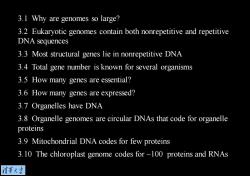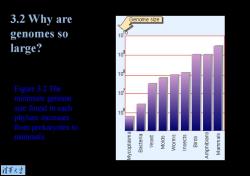清华大学:《分子生物学》课程PPT教学课件(基因ene)第三章 有多少基因(How many genes are there)

Chapter 3 How many genes are there? 清苇大当
Chapter 3 How many genes are there?

3.1 Why are genomes so large? 3.2 Eukaryotic genomes contain both nonrepetitive and repetitive DNA sequences 3.3 Most structural genes lie in nonrepetitive DNA 3.4 Total gene number is known for several organisms 3.5 How many genes are essential? 3.6 How many genes are expressed? 3.7 Organelles have DNA 3.8 Organelle genomes are circular DNAs that code for organelle proteins 3.9 Mitochondrial DNA codes for few proteins 3.10 The chloroplast genome codes for ~100 proteins and RNAs 清菜大当
3.1 Why are genomes so large? 3.2 Eukaryotic genomes contain both nonrepetitive and repetitive DNA sequences 3.3 Most structural genes lie in nonrepetitive DNA 3.4 Total gene number is known for several organisms 3.5 How many genes are essential? 3.6 How many genes are expressed? 3.7 Organelles have DNA 3.8 Organelle genomes are circular DNAs that code for organelle proteins 3.9 Mitochondrial DNA codes for few proteins 3.10 The chloroplast genome codes for ~100 proteins and RNAs

3.1 Introduction Genome is the complete set of sequences in the genetic material of an organism.It includes the sequence of each chromosome plus any DNA in organelles. Proteome is the total number of proteins produced I by an organism Transcriptome is the complete set of mRNAs present in a cell,tissue,or organism 清菜大当
Genome is the complete set of sequences in the genetic material of an organism. It includes the sequence of each chromosome plus any DNA in organelles. Proteome is the total number of proteins produced by an organism. Transcriptome is the complete set of mRNAs present in a cell, tissue, or organism. 3.1 Introduction

3.2 Why are genomes so large? C-value is the quantity of DNA in the genome (per haploid set of chromosomes) Nonrepetitive DNA shows reassociation kinetics expected of unique sequences Repetitive DNA behaves in a reassociation reaction as though many (related or identical) sequences are present in a component, allowing any pair of complementary sequences to reassociate 清苇大当
C-value is the quantity of DNA in the genome (per haploid set of chromosomes). Nonrepetitive DNA shows reassociation kinetics expected of unique sequences. Repetitive DNA behaves in a reassociation reaction as though many (related or identical) sequences are present in a component, allowing any pair of complementary sequences to reassociate. 3.2 Why are genomes so large?

3.2 Why a are Flowering plants genomes so Birds Mammals large? Reptiles Amphibians Bory fish Figure 3.I DNA content of Cartilaginous fisl万 Echinoderms the haploid genome is Crustaceans related to the morphological Insects Mollusks complexity of lower worms eukaryotes.but varies Molds extensively among the Algae Fungi higher eukaryotes.The Gram(+)bacteria Gram(-)bactera range of DNA values within Mycoplasma a phylum is indicated by the 101010310310U10 shaded area 情菜大当
Figure 3.1 DNA content of the haploid genome is related to the morphological complexity of lower eukaryotes, but varies extensively among the higher eukaryotes. The range of DNA values within a phylum is indicated by the shaded area. 3.2 Why are genomes so large?

3.2 Why are Genome size genomes so 0 10 large? 109 109 Figure 3.2 The 10 minimum genome size found in each 10 phylum increases from prokaryotes to mammals ewse jdooAw sea spIoW s1oasul spulg 清菜大当
Figure 3.2 The minimum genome size found in each phylum increases from prokaryotes to mammals. 3.2 Why are genomes so large?

3.2 Why are genomes so large? Phylum Species Genome (bp) Algae Pyrenomas salina 6.6×105 Mycoplasma M.pneumoniae 1.0X19 Bacterium E.coli 4.2x109 Yeast S. cerevisiae 1.3×10 Slime mold D.discoideum 5.4×107 Nem atode C.elegans 8.0×107 Insect D.melanogaster 1.4× 108 Bird G.domesticus 1.2x 109 Amphibian X.laevis 3.1×109 Mammal H. sapiens 3.3× 109 Figure 3.3 The genome sizes of some common experimental animals 情菜大当
Figure 3.3 The genome sizes of some common experimental animals. 3.2 Why are genomes so large?

Rate of reaction 3.2 Eukaryotic The reaction follows the second order equation =-02 dt genomes have C is the concentration of DNA that is single-stranded at time t k is a reassociation rate constant. several sequence components Progress of reaction Integrate the rate equation between the limits: initial concentration of DNA =Coat time t=0; concentration remaining single stranded=C after time t 1 Co 1+k.Cot Critical parameter is Coty When the reaction is half complete at time t=V Figure 3.4 A DNA C 1 1 reassociation reaction is Co 2 1+k.Coty described by the Cotzn Therefore 1 Coty= 清菜大当
Figure 3.4 A DNA reassociation reaction is described by the C0 t2/1 3.2 Eukaryotic genomes have several sequence components

3.2 Eukaryotic genomes have Genome several sequence 35001.7×10°4.2×10°bp components 100% Poly U:poly A MS2 T4 E.coli Figure 3.5 Rate of reassociation is inversely proportional to 10910510410310210110102 the length of the reassociating DNA 2×106 8×1033×1019 .Cot 情菜大当
Figure 3.5 Rate of reassociation is inversely proportional to the length of the reassociating DNA. 3.2 Eukaryotic genomes have several sequence components

3.2 Eukaryotic Fraction reassociated(1-C/Co) 100 genomes have several sequence 75 components 50 Figure 3.6 The 25 reassociation kinetics of eukaryotic DNA show 3 10 10 102 10 10 10 103 10 types of component Cot (indicated by the shaded Fast Intermediate Slow areas).The arrows component component component Percent of genome 25 30 45 identify the Cot values 0.0013 1.9 630 for each component Complexity,bp 340 6.0×105 3.0×10 Repetition frequency 500.000 350 1 清菜大当
Figure 3.6 The reassociation kinetics of eukaryotic DNA show 3 types of component (indicated by the shaded areas). The arrows identify the Cot1/2 values for each component. 3.2 Eukaryotic genomes have several sequence components
按次数下载不扣除下载券;
注册用户24小时内重复下载只扣除一次;
顺序:VIP每日次数-->可用次数-->下载券;
- 清华大学:《分子生物学》课程PPT教学课件(基因ene)第二章 从基因到基因组(From Genes to Genomes).ppt
- 清华大学:《分子生物学》课程PPT教学课件(基因ene)第一章 基因是DNA(Genes are DNA).ppt
- 清华大学:《分子生物学》课程PPT教学课件(基因ene)绪论 Molecular Biology(主讲:王钊).ppt
- 河北农业大学:《分子生物学》课程教学资源(PPT课件)第十二章 免疫多样性产生的机制.ppt
- 河北农业大学:《分子生物学》课程教学资源(PPT课件)第十一章 病毒的分子生物学.ppt
- 河北农业大学:《分子生物学》课程教学资源(PPT课件)第十章 遗传重组.ppt
- 河北农业大学:《分子生物学》课程教学资源(PPT课件)第九章 真核生物基因表达调控.ppt
- 河北农业大学:《分子生物学》课程教学资源(PPT课件)第八章 原核生物基因表达调控.ppt
- 河北农业大学:《分子生物学》课程教学资源(PPT课件)第七章 蛋白质翻译(Protein Translation).ppt
- 河北农业大学:《分子生物学》课程教学资源(PPT课件)第六章 RNA转录(RNA transcription).ppt
- 河北农业大学:《分子生物学》课程教学资源(PPT课件)第五章 DNA损伤、修复和突变.ppt
- 河北农业大学:《分子生物学》课程教学资源(PPT课件)第四章 DNA复制(DNA Replication).ppt
- 河北农业大学:《分子生物学》课程教学资源(PPT课件)第三章 有机体、染色体和基因.ppt
- 河北农业大学:《分子生物学》课程教学资源(PPT课件)第二章 DNA的结构.ppt
- 河北农业大学:《分子生物学》课程教学资源(PPT课件)第一章 绪论.ppt
- 《微生物学》课程教学资源(参考资料)微生物基本术语(英汉对照词汇).pdf
- 南京师范大学:《微生物学》课程PPT教学课件(实验指导)实验九 噬菌体的分离.ppt
- 南京师范大学:《微生物学》课程PPT教学课件(实验指导)实验八 微生物的生理生化反应.ppt
- 南京师范大学:《微生物学》课程PPT教学课件(实验指导)实验七 环境因素对微生物的影响.ppt
- 南京师范大学:《微生物学》课程PPT教学课件(实验指导)实验六 微生物的接种技术及分离纯化.ppt
- 清华大学:《分子生物学》课程PPT教学课件(基因ene)第四章 簇和重复(Clusters and repeats).ppt
- 清华大学:《分子生物学》课程PPT教学课件(基因ene)第五章 信使RNA(Messenger RNA).ppt
- 清华大学:《分子生物学》课程PPT教学课件(基因ene)第六章 蛋白质合成(Protein synthesis).ppt
- 清华大学:《分子生物学》课程PPT教学课件(基因ene)第七章 遗传密码的利用(Using the genetic code).ppt
- 清华大学:《分子生物学》课程PPT教学课件(基因ene)第八章 蛋白质定位(Protein localization).ppt
- 清华大学:《分子生物学》课程PPT教学课件(基因ene)第九章 转录(Transcription).ppt
- 清华大学:《分子生物学》课程PPT教学课件(基因ene)第十章 操纵子(The operon).ppt
- 清华大学:《分子生物学》课程PPT教学课件(基因ene)第十一章 噬菌体的战略(Phage strategies).ppt
- 清华大学:《分子生物学》课程PPT教学课件(基因ene)第十二章 复制子(The replicon).ppt
- 清华大学:《分子生物学》课程PPT教学课件(基因ene)第十三章 DNA复制(DNA replication).ppt
- 清华大学:《分子生物学》课程PPT教学课件(基因ene)第十四章 重组和修复(Recombination and repair).ppt
- 清华大学:《分子生物学》课程PPT教学课件(基因ene)第十五章 转座子(Transposons).ppt
- 清华大学:《分子生物学》课程PPT教学课件(基因ene)第十六章 逆转录病毒和逆转座子(Retroviruses and retroposons).ppt
- 清华大学:《分子生物学》课程PPT教学课件(基因ene)第十七章 DNA的重新排列(Rearrangement of DNA).ppt
- 清华大学:《分子生物学》课程PPT教学课件(基因ene)第十八章 染色体(Chromosomes).ppt
- 清华大学:《分子生物学》课程PPT教学课件(基因ene)第十九章 核小体(Nucleosomes).ppt
- 清华大学:《分子生物学》课程PPT教学课件(基因ene)第二十章 转录的起始(Initiation of transcription).ppt
- 清华大学:《分子生物学》课程PPT教学课件(基因ene)第二十一章 转录的调控(Regulation of Transcription).ppt
- 清华大学:《分子生物学》课程PPT教学课件(基因ene)第二十二章 核的剪切(Nuclear splicing).ppt
- 清华大学:《分子生物学》课程PPT教学课件(基因ene)第二十三章 催化RNA(Catalytic RNA).ppt
